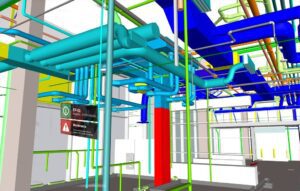At JMKON LLC, we harness the advantages of Building Information Modeling (BIM) to revolutionize both the design and construction phases of our projects. As a leading construction management company in America, we understand that leveraging the advantages of BIM throughout these critical phases sets the foundation for successful project outcomes. Here’s how BIM transforms each phase and brings long-term benefits to your construction projects:
Benefits of building information modeling

- Enhanced Collaboration: One of the most significant advantages of BIM is its ability to foster real-time collaboration among various stakeholders, including architects, engineers, contractors, and clients. By working from a shared digital workspace, team members can coordinate efficiently, detect potential clashes early, and make informed decisions in real-time. This greatly enhances increased collaboration, construction planning, and the elimination of communication errors across the board.
- Reduced Costs: BIM enables cost savings by minimizing errors, reducing rework, and improving the accuracy of project estimates. Through advanced cost estimation, BIM for cost savings in construction helps control project budgets effectively. The ability to simulate construction processes before they start helps avoid costly changes and delays on-site. Additionally, BIM for reducing construction errors offers better control over resources, optimizing material use, reducing waste, and improving energy consumption and space management.
- Improved Project Outcomes: BIM provides a comprehensive view of the project, facilitating better quality control, safety management, and construction planning. BIM for improved design accuracy ensures projects meet client expectations while adhering to sustainability goals. By using BIM for building lifecycle management, we ensure ongoing maintenance and facility management, supporting long-term operational success.
- Sustainability Advantages of BIM: One of the key benefits of BIM is its impact on enhanced sustainability. BIM integrates energy performance data, improving environmental impacts, waste reduction, and lifecycle assessment for buildings. By modeling energy-efficient designs and reducing resource consumption, BIM for sustainability helps projects achieve energy savings and environmentally responsible outcomes.
A well-planned BIM implementation strategy transforms the way construction projects are managed, resulting in smoother workflows, enhanced efficiency, and successful project outcomes.
Know more about: The Role of BIM in Construction Industry.
Advantages of BIM in Construction in Each Phase
Design Phase
BIM in the design phase integrates all elements into a cohesive digital model, improving collaboration, planning, and execution. Here are the key advantages:
- Improved Visualization: 3D modeling with BIM offers detailed digital representations of the building, enabling teams to identify potential design issues early.
- Enhanced Collaboration: Stakeholders like architects, engineers, and contractors collaborate more effectively using a shared digital workspace, improving overall communication and decision-making.
- Accurate Data and Documentation: BIM ensures up-to-date project information is shared with all stakeholders, preventing costly construction errors.
- Clash Detection: Identifies and resolves conflicts between building systems before construction starts, leading to cost savings.
- Cost and Time Efficiency: BIM enhances time efficiency in construction, reducing delays and preventing budget overruns by integrating cost estimation into the planning process.
Construction Phase
During the construction phase, BIM continues to streamline operations and improve project outcomes:
- Enhanced Project Coordination: BIM enables real-time collaboration and coordination across all parties, reducing errors and misunderstandings that can lead to delays.
- Improved Scheduling: BIM links the 3D model to construction timelines, ensuring precise scheduling and real-time adjustments, which helps with reducing construction time and cost.
- Accurate Cost Estimation: BIM integrates detailed cost estimation for better budgeting and financial planning, resulting in more effective cost savings over the project’s lifecycle.
- Clash Detection and Risk Management: BIM proactively identifies clashes and supports risk management, minimizing rework and delays. It also helps manage safety hazards during construction.
- Efficient Resource Management: By integrating off-site fabrication and optimizing material, labor, and equipment allocation, BIM ensures efficient resource use and reduced energy consumption.
- Improved Quality Control: BIM ensures construction accuracy, adhering to design specifications and improving quality control, which leads to safer, higher-quality buildings.
How JMKON LLC Utilizes BIM building modeling

At JMKON LLC, we leverage BIM integration across all projects to deliver superior outcomes:
- Optimizing Coordination: Promotes increased collaboration and communication among stakeholders, improving overall project efficiency.
- Enhancing Scheduling: Ensures projects stay on track with efficient construction planning and scheduling strategies, improving time efficiency.
- Controlling Costs: Integrates precise cost estimations to manage project budgets effectively, resulting in significant cost savings throughout the project lifecycle.
- Early Clash Detection: Identifies and resolves conflicts early on, minimizing disruptions during construction and supporting risk management.
- Resource Management: Maximizes efficiency in material and labor use, reducing waste, improving space management, and lowering energy consumption for more sustainable outcomes.
- Ensuring Quality: Maintains high standards of quality control throughout the project, ensuring improved quality and safety and delivering high-quality results for clients.
Learn more about the Top 5 BIM Misconceptions
Conclusion
BIM is a transformative tool in the construction industry, empowering us at JMKON LLC to deliver projects with enhanced construction planning, collaboration, and sustainability advantages. By leveraging BIM for facility management, BIM for improved project delivery, and BIM for reducing construction errors, we consistently achieve better project outcomes, exceed client expectations, and deliver long-term value.
For more information on how JMKON LLC can enhance your next project using BIM, contact us today!





